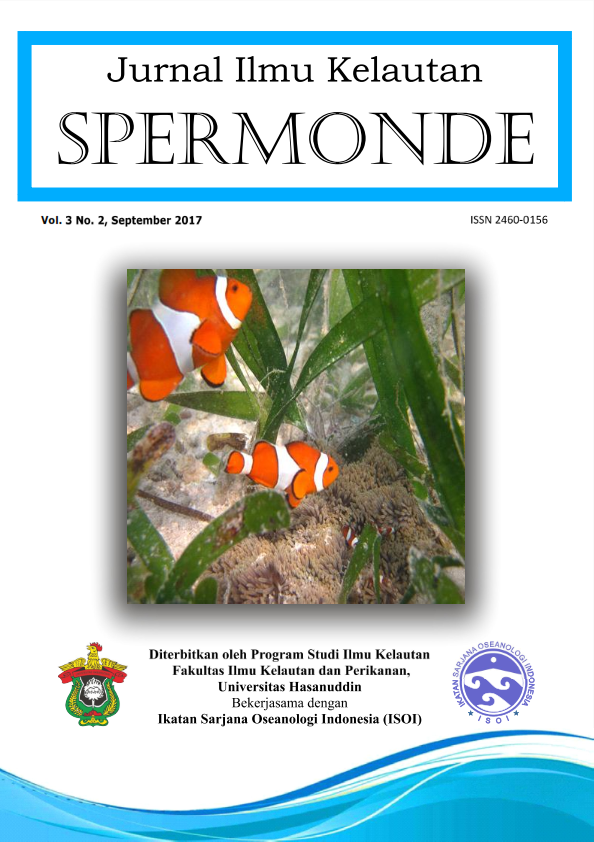KARAKTERISASI KONDISI KIMIA-FISIKA LINGKUNGAN PADA TINGKATAN DENSITAS MANGROVE YANG BERBEDA DI AMPALLAS, KABUPATEN MAMUJU, SULAWESI BARAT
DOI:
https://doi.org/10.20956/jiks.v3i2.3006Abstract
Mangroves have numerous ecological functions as well as economical values. In order to achieve successful of mangrove restoration and regain its functions, understanding on the factors affecting the establishment of mangroves are required. This study examined the characteristics of physico-chemical factors from three compartments (sediment, interstitial and seawater) that associated with different mangrove densities in Ampallas, District of Mamuju, West Sulawesi. The Principal Component Analysis and Spearman correlation analysis showed that high densities of adult and seedling mangroves strongly correlated to higher organic contents, dissolved oxygen of interstitial water, seawater salinities and lesser pH of sediments, seawater and interstitial. The reverse conditions applied for the less mangrove densities and control site that had no mangrove. In most cases, there were reciprocal relationships amongst the studied variables.
Keywords: chemical-physical factors, density, mangroves.
References
Ahmed, E. A. and Abdel-Hamid, K. A. 2007.
Zonation Pattern of Avicennia marina and
Rhizophora mucronata along the Red Sea Coast,
Egypt. World Applied Sciences Journal, 2:
-288.
Duke, N. C., Ball, M. C. and Ellison, J. C.
Factors influencing biodiversity and
distributional gradients in mangroves. Global
Ecology and Biogeography Letters, 7: 27-
FAO 2007. The World’s Mangroves 1980-2005.
Food and Agriculture Organization of the
United Nations. Rome. Italy.
Gillis, L. G., Zimmer, M. and Bouma, T. J. 2016.
Mangrove leaf transportation: Do mimic
Avicennia and Rhizophora roots retain or
donate leaves? Marine Ecology Progress
Series, 551: 107-115.
Hastuti, E. D., Anggoro, S. and Pribadi, R. 2016.
Dynamic linkages of mangrove Rhizophora
mucronata and its environment parameters
in Semarang and Demak coastal area.
International Journal of Applied Environmental
Sciences, 11: 279-293.
Heiri, O., Lotter, A. F. and Lemcke, G. 2001.
Loss on ignition as a method for estimating
organic and carbonate content in sediments:
reproducibility and comparability of
results. Journal of Paleolimnology, 25: 101-
Hogarth, P. 2007. The Biology of Mangroves and
Seagrasses. Oxford University Press. New
York, USA.
Kathiresan, K. and Bingham, B. L. 2001. Biology
of mangroves and mangrove ecosystems.
Advances in Marine Biology, 40: 81-251.
Marchand, C., Baltzer, F., Lallier-Vergés, E. and
Albéric, P. 2004. Pore-water chemistry in
mangrove sediments: relationship with species
composition and developmental stages (French
Guiana). Marine Geology, 208: 361-381.
Percival, J. B. and Lindsay, P. J. 1997. Chapter
two. Measurement of physical properties of
sediments. In Mudroch, A., Azcue, J. M., and
Mudroch, P., editor. Manual of Physico-
Chemical Analysis of Aquatic Sediments.
CRC Press, Inc. Florida. USA.
Saenger, P. 2002. Mangrove Ecology, Silviculture
and Conservation. Kluwer Academic
Publishers. Netherlands.
Sundby, B., Vale, C., Caetano, M. and Luther, G.
W. 2003. Redox Chemistry in the Root Zone of
a Salt Marsh Sediment in the Tagus Estuary,
Portugal. Aquatic Geochemistry, 9: 257-271.
Downloads
Published
Issue
Section
License
Copyright (c) 2017 Jurnal Ilmu Kelautan SPERMONDE

This work is licensed under a Creative Commons Attribution-NonCommercial 4.0 International License.

This work is licensed under a Creative Commons Attribution 4.0 International License




 sdsd
sdsd








